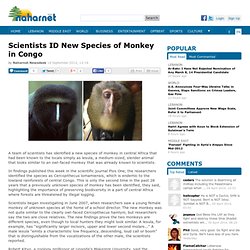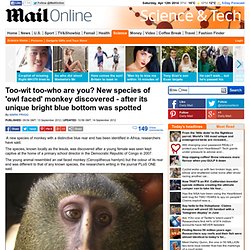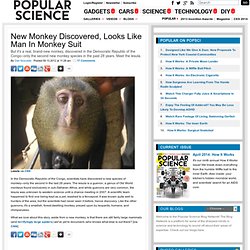

Scientists ID New Species of Monkey in Congo. A team of scientists has identified a new species of monkey in central Africa that had been known to the locals simply as lesula, a medium-sized, slender animal that looks similar to an owl-faced monkey that was already known to scientists.

In findings published this week in the scientific journal Plos One, the researchers identified the species as Cercopithecus lomamiensis, which is endemic to the lowland rainforests of central Congo. This is only the second time in the past 28 years that a previously unknown species of monkey has been identified, they said, highlighting the importance of preserving biodiversity in a part of central Africa where forests are threatened by illegal logging. The colourful new species of African 'owl faced' monkey. By Mark Prigg Published: 09:54 GMT, 13 September 2012 | Updated: 10:56 GMT, 14 September 2012 A new species of monkey with a distinctive blue rear end has been identified in Africa, researchers have said.

The species, known locally as the lesula, was discovered after a young female was seen kept captive at the home of a primary school director in the Democratic Republic of Congo in 2007. The young animal resembled an owl faced monkey (Cercopithecus hamlyni) but the colour of its rear end was different to that of any known species, the researchers writing in the journal PLoS ONE said. New monkey species has bright blue bottom. YALE (US) — Scientists have found a new monkey species in remote central Congo, where bush meat hunting and habitat loss threaten their survival.

It is one of only two new species of African monkey discovered since the mid-1980s. The slender, medium-sized primate—called a Lesula (luh-SOO-la) and roughly similar to a vervet monkey—represents a rare discovery of a previously undocumented mammal, and helps establish this sparsely settled region of the Democratic Republic of Congo as an important source of biodiversity, researchers says. The researchers describe the Lesula and its sister species as “shy, quiet, and generally occur[ing] in small groups.” View larger. (Credit: Terese Hart/Flickr) They describe the animal in detail for the first time in the September 12 issue of the journal PLOS ONE.
“This was a totally unexpected find, and we knew we had something unusual and possibly unknown when we first saw the animal. Shy and quiet Source: Yale. New Monkey Discovered, Looks Like Man in Monkey Suit. In the Democratic Republic of the Congo, scientists have discovered a new species of monkey--only the second in the last 28 years.

The lesula is a guenon, a genus of Old World monkeys found exclusively in sub-Saharan Africa, and while guenons are very common, the lesula was unknown to western science until a chance meeting in 2007. A scientific team happened to find one being kept as a pet, leashed to a fencepost. It was known quite well to hunters of the area, but the scientists had never seen it before, hence discovery.
Like the other guenons, it's a smallish, forest-dwelling monkey, preyed upon by leopards, humans, and chimpanzees. What we love about this story, aside from a new monkey, is that there are still fairly large mammals (and terrifyingly large spiders) we've yet to document--who knows what else is out there? New monkey discovered. The Lesula, or Cercopithecus lomamiensis, is the first new species of monkey found in 28 years.

Georgette, the daughter of a local school director in Opala, DR Congo, with her pet Lesula -- the find that led biologists to identify the new species. Initially scientists were not sure if the adult male Owl Face on the left and the Lesula on the right were the same species. The differences in the skulls of the Owl-Faced monkey (right) and the Lesula (left). The most easily observable differences illustrated by the skulls and the plot below are that the lesula has larger eyes, a narrower distance between the orbits, and a more flexed back of the cranium. Georgette's monkey was well-known to local hunters but she lives in a part of DR Congo that is among the least biologically explored forests.